
You’re probably not wandering along the Donaukanal arm of the Danube in pursuit of neogothic roof designs, but the riverside buildings include a modern and historical delight or two to go with your cold drink.
- Highlights includes buildings by Hundertwasser, Wagner and Hadid
- Also examples from the Wiener Moderne era
- See also:
Bridges, barracks and the bizarre
Let us stroll down from north to south on this map and discover the marked highlights:
Nip off to either side of the channel, of course, and you’ll find many of Vienna’s landmark sights. But we’re keeping to the bankside paths on this journey…
Schemerlbrücke

(View from the bridge)
The Donaukanal more or less branches off from the Danube at the Schemerlbrücke, a bridge and weir system built at the very end of the 1890s.
The architect was none other than the father of modern architecture, Otto Wagner. And the two bronze lions at either end come from the hands and chisel of Rudolf Weyr, whose work appears in many of Vienna’s 19th-century landmarks. (Weyr also crafted the city’s monument to Brahms, for example.)
“Popular” culture
Then we have a long stretch lacking in historical flair, but with places of sociocultural and contemporary interest.
For example, two of Austria’s biggest media organisations live alongside the Donaukanal.

(The Kronen Zeitung is Austria’s largest newspaper)
With hundreds of thousands of copies distributed daily, “the Krone” sells more than all but the biggest UK national papers, for example, even though the UK has roughly seven times the population of Austria.

(Ö3 is the country’s most popular radio station)
Around 2.4 million listeners tune in each day for Ö3’s largely pop-filled programming. The station is part of the state broadcaster ORF (Austria’s BBC).
Spittelau
Just as the channel begins to curve back toward the east, we reach a rather special piece of city infrastructure.
Historically, Spittelau referred to the marshland around this part of the Danube. Today, people mostly associate the name with the subway station and incinerator at this location.
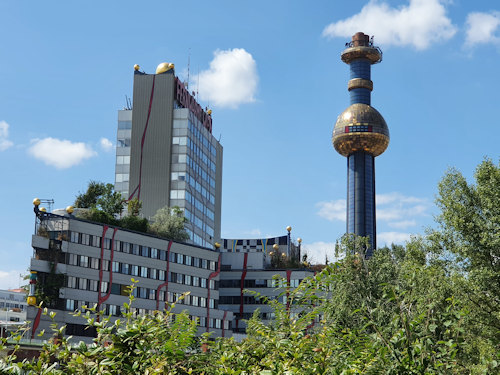
(View across from the Donaukanal)
The rather mundane-sounding Spittelau municipal incinerator turns out to be a piece of iconic modern architecture.
Redesigned by Friedensreich Hundertwasser in the early 1990s, the building features the artist’s typical mosaic of colour and form, including a golden sphere on the chimney that has become a true city landmark.
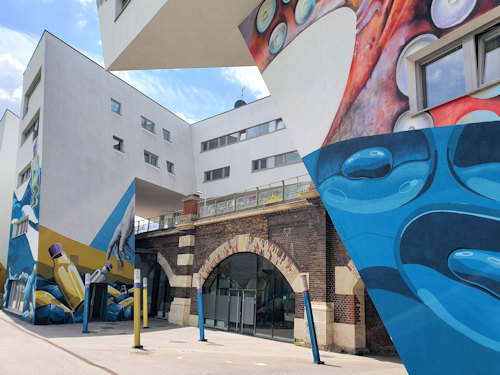
(They added the street art later)
Just down from the incinerator is the housing block originally designed by star architect, Zaha Hadid, and built around the old railway arches.
The project made a startling bit of modern architecture in its own right, but the street paintings now emblazoned across much of the lower parts have turned it into an even more fascinating addition to the riverside landscape.
Rossauer barracks and Ringturm
The Donaukanal eventually skirts the edge of the old town, which you might wander off into to enjoy the palaces, museums and coffee houses.
As you approach the “entrance” to the old town stretch, you see the large Rossauer barracks and Ringturm skyscraper (skyscraper in the restrained Viennese sense of the word).

(Construction ended in 1869)
The barracks formed part of a series of military installations created after the 1848 mini-revolution in case the lower classes got cheeky again. (Political dialogue and compromise not being natural characteristics of Habsburg emperors.)
The building housed the Federal Ministry of Defence last time I checked.
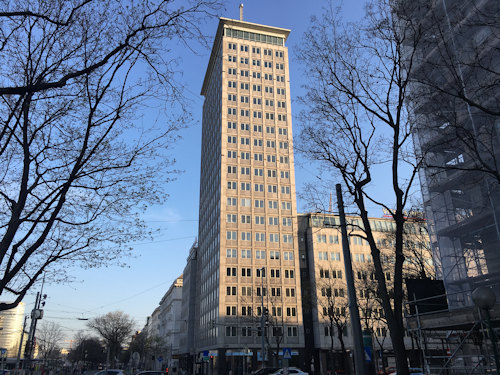
(Inspired by US cityscapes)
The Ringturm went up in 1955 as a quasi symbol of Austria’s post-WWII economic recovery.
Although insurance offices, it still slots nicely into Vienna’s cultural landscape: the Ringturm hosts a regular architectural exhibition and summer normally sees a giant piece of artwork cover the façade.
More Wagner
The bank opposite the Ringturm has another construction by Otto Wagner: the Schützenhaus, completed in the first decade of the 20th century.

(That man Wagner again)
This water regulation facility never entered operation and now contains a restaurant. Which seems apt for Vienna and allows me a “turning water into wine” joke. (Ba dum and, indeed, tish.)
The Schützenhaus also provided an outdoor location for the movie, Before Sunrise.
High-rise views

(The SO/ Vienna hotel)
As you continue around to the other end of the old town, various high-rise offices for banks, insurance companies etc. pop up on the northern bank of the Donaukanal.
A special mention goes to the The SO/ Vienna hotel building, simply because it houses the Das LOFT restaurant at the very top with spectacular views over the old town.
Urania

(Also home to a cinema)
Then, as we leave the old town behind, we have the much-loved Urania building by architect Max Fabiani from 1910. Although not as modernist as many might have liked, the unique elongated structure and presence where the River Wien joins the Donaukanal has given it a certain cult status locally.
More importantly, the Urania began life (and continues) as a place of public education with lecture halls, an observatory, and more.
Austrians were first introduced to the stunning technological advancement of (gasp!) talking films in this very building.
Jugendstil(ish)
Beyond the Urania, the buildings begin to thin out as we move into more green spaces and industrial areas. Keep an eye out, though, for the row of houses along Weißgerberlände on the south bank.

(Balconies and façade in the Jugendstil style)
Many of those buildings represent a pot pourri of turn-of-the-century architecture that includes Jugendstil and other elements from the Wiener Moderne.
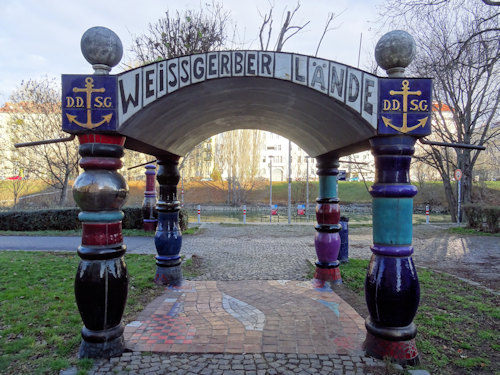
(The trademark curved and colourful approach of Friedensreich Hundertwasser)
We also meet Hundertwasser again in the form of a small dock he designed.
Incidentally, the Hundertwasserhaus and Hundertwasser Museum are both just a short walk from this point.
Tri(ii)ple towers
Should you desire a longer walk and continue away from the centre toward the south and east, a remaining architectural highlight is the collection of towers around the Erdberg area (which has a convenient U3 subway station for getting back into town faster).
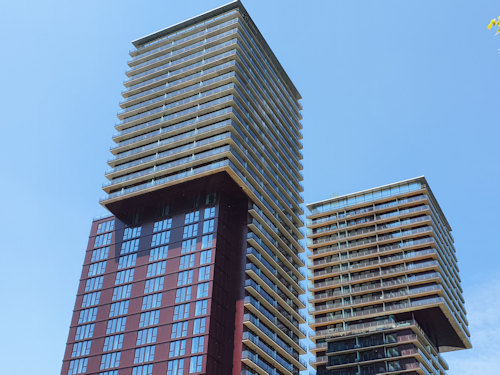
(The Triiiple Towers)
The Wien Energie and Wiener Stadtwerke buildings mark the skyline, but also the Triiiple Towers: a 33-storey, three-tower apartment complex constructed in 2021 alongside the river to a unique design.
Which brings us to the end of our quick architectural tour. For an overview of all that the Donaukanal has to offer, including nature, river trips, art, and sustenance, see here.